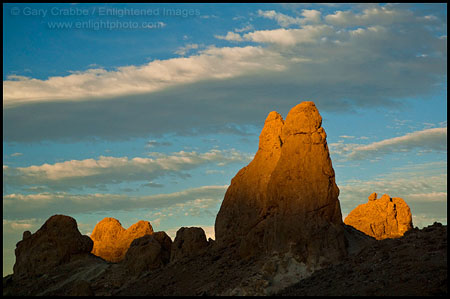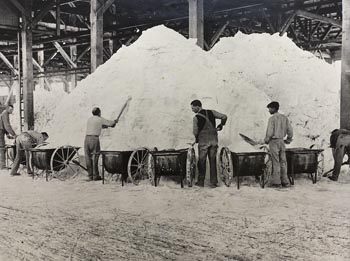Picture: Sunset light on the Trona Pinnacles, near Ridgecrest, California

Yesterday I announced through my Facebook & Twitter profiles that I’d just completed a weeks long edit of a 10 day trip I took last fall to Death Valley & the Sierra while working on my book, California; Yesterday & Today. It turned out that after reviewing nearly 3100 images, I processed 635 Raw photos using Adobe Lightroom. It was interesting to hear some of the comments and feedback I received, so I thought it would be fun to share a bit of my edited results.
First, a quick note on the process side. When I import images into Lightroom from a memory card, I rename the image files based on the card, date & location, followed by a sequence number. For example 091018c_TRNA-0186 means it was the third 4GB CF card I used that day 2009, October 18th, the primary location or region, and the image file number from that CF card. I then look through each set or bracket of shots, pick the best variation(s), and process them in the Lightroom Develop module. I then export all converted images as 16-bit TIFF files, then run all images through a batch action in Photoshop to resize to 300 dpi @ 12×18″.
This is the result of one afternoon and morning shoot, 72 images from Trona, California. This starts after leaving Death Valley, and ends the next morning as I was leaving the Trona Pinnacles. These images are what I would call in my “Second State” of editing. Some images may get saved in my archive for possible client variations, others may get deep filed for use in potential slide shows, presentations, workshops, or lectures. Images destined for my agents or web site will likely get one more round of processing on a per-image basis through Photoshop to optimize colors, tones, and details that might not have gotten as closely addressed when working in Lightroom. For most images, Lightroom represents the rough draft, while photoshop represents the finished work. Obviously some images need very little (if any) change from Lightroom, while others benefit from what I call the “refined massage.”
So how would I personally rank this one day’s worth of edited images? Nice, but nothing spectacular; meaning I don’t see anything here that is automatically “portfolio-worthy.” Still, I’m quite happy with the results.
And speaking of Trona, I’d like to give a huge shout-out of thanks to the very kind ladies at the Searles Valley Historical Society in Trona. They have a great collection of images and items, and would make for a very worthwhile stop for anyone traveling between Death Valley & Ridgecrest. Here are a couple images that they were nice enough to loan me for possible use in my book. Unfortunately, Trona didn’t make the final edit, …er, cut. But do please stop by if you get the chance, and tell them you learned about them from me. We’d all appreciate it. – Thanks again, ladies.
Picture: Trona Pinnacles Photo Courtesy: Searles Valley Historical Society

Picture: Bulk handling of Potash, Trona Mill, Trona, California; 1919 Photo Courtesy: Searles Valley Historical Society

